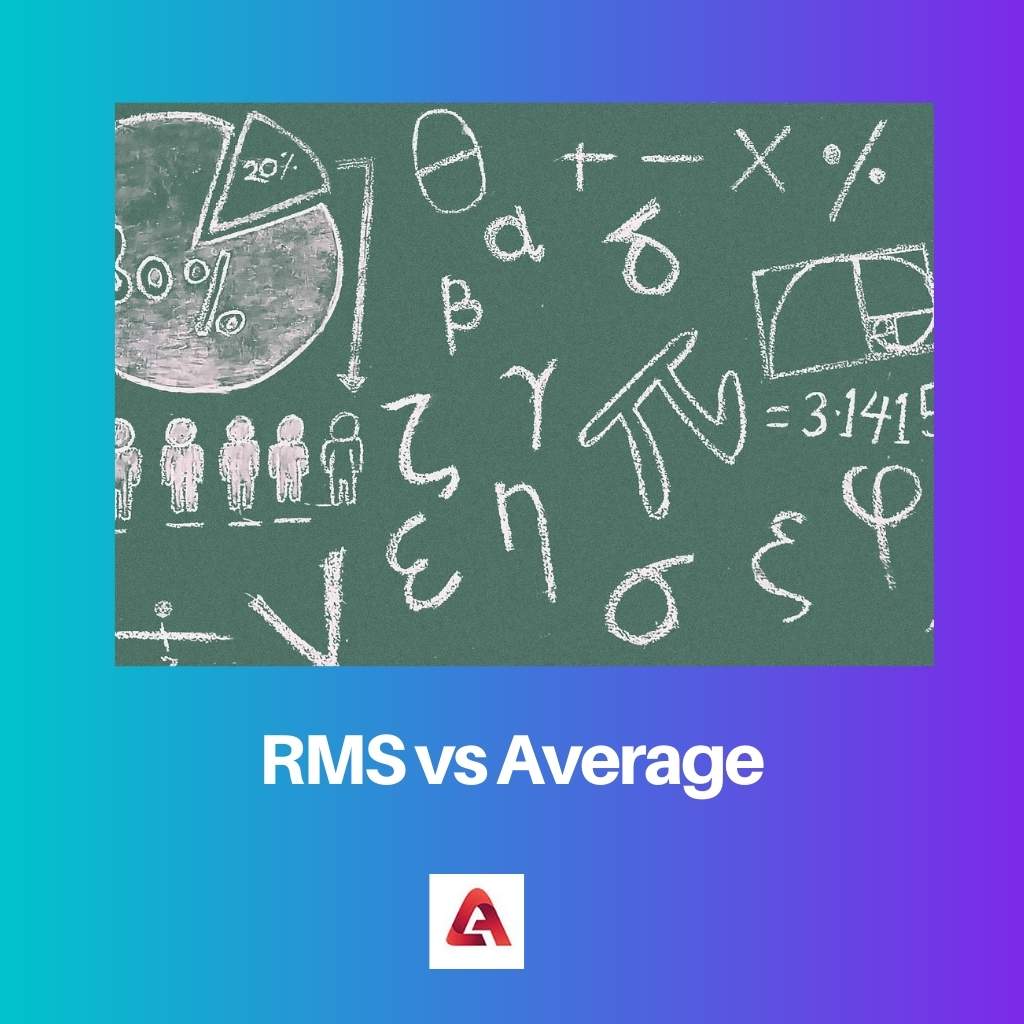Mathematics uses the terms root-mean-square (RMS) and average to define the overall character of a group of numbers.
Key Takeaways
- RMS (Root Mean Square) represents the square root of the mean of the squared values in a dataset.
- Average, or mean, is the sum of values in a dataset divided by the number of values.
- RMS is beneficial for analyzing varying quantities, while the average is more appropriate for constant or linear quantities.
RMS vs Average
In mathematics, root mean square (RMS) calculates the square root of the average value of the squares of a group of numbers. RMS helps determine the effective value of an AC wave shape. Average refers to the mean value of a set of numbers. It is calculated by dividing the sum of all the values by the number of values present.

The root-mean-square is a mathematical term representing the square root of the mean square. The arithmetic means square of the squares of a group of values is known as the mean square.
It is a way of representing a big number of numbers with a single one. Every digit given in the data set is represented by a single number.
Comparison Table
| Parameters of Comparison | RMS | Average |
|---|---|---|
| Also known as | Effective value | Mean value |
| The formula for Sine Wave | VRMS = VPK/√2 | VAV = 0 |
| The formula for Full rectified wave | VRMS = VPK/√2 | VAV = 0.637 VPK |
| The formula for Half rectified wave | VRMS = VPK/2 | VAV = 0.318 VPK |
| Degree of usage | Most in Mathematical fields | Most in Electrical physics fields |
What is RMS?
If the function has a continuously changing value, RMS is defined as the integral of the squares of the instantaneous values squared throughout the cycle.
If the estimate does not fit the data well, it will have a large root-mean-square deviation (RMSD).
The RMS voltage can also be defined as the integral of the squares of the instantaneous values during a cycle for a constantly fluctuating voltage.
If a periodic function has a period, then its RMS is equal to the RMS of the first period. Using the RMS value of a pattern composed of equally spaced observations, we can approximate the RMS value of a non-stop characteristic or signal.
What is Average?
The sum of all the numbers in a collection divided by the total number of numbers in the collection is the arithmetic mean or average.
To determine the average age of a class, the teachers gather the pupils’ ages and average them out.
Averaging all these values yields a single number that may be used to represent everything.
As a result, there are several different mathematical definitions of mean, including arithmetic, geometric, harmonic, and weighted.
Main Differences Between RMS and Average
- The average, on the other hand, can be stated in a variety of ways, including the mean, median, or mode.
- RMS is critical in electrical engineering and signal sciences, although the average is common in statistics.
- https://ieeexplore.ieee.org/abstract/document/1166333/
- https://onlinelibrary.wiley.com/doi/abs/10.1111/j.1365-2478.1974.tb00099.x

The section on ‘What is RMS?’ is particularly insightful. It offers a comprehensive understanding of how RMS is defined and utilized.
The examples provided for the calculation of RMS and Average are very helpful in illustrating the application of these mathematical terms.
I found the detailed explanation of RMS very informative. It clarified many aspects of the concept that I was unclear about.
The in-depth explanation of RMS and Average, along with their distinct applications, makes this article a valuable educational piece for those seeking a comprehensive understanding of mathematical measurements.
The author’s articulation of the concept of RMS and Average sets a high standard for clarity and precision in mathematical exposition.
The comparison of RMS and Average highlights the distinctive nature of these terms, making it easier for readers to comprehend their unique roles in mathematical and electrical contexts.
The detailed references provided in the article are a valuable resource for readers who want to explore this topic further.
The insights into the main differences between RMS and Average are presented with clarity and precision, enhancing the overall quality of the article.
The analogies used to explain RMS and Average are well-crafted and contribute to a better understanding of the concepts.
I think the article provides valuable information about the significance of RMS and Average in quantitative analysis.
The explanation of RMS and Average is enlightening, especially for readers who are not familiar with mathematical terminologies.
It’s great to have the comparison table for RMS and Average. It provides a clear overview of the differences between the two.
The discussion on the ‘Main Differences Between RMS and Average’ provides a robust foundation for comprehending the practical use cases of these mathematical measures.
The article’s approach to elucidating the utility of RMS in electrical engineering and the prevalence of the average in statistics is commendable.
This article successfully bridges the gap between complex mathematical concepts and real-world applications, making it a valuable resource for students and professionals alike.
This is a very interesting topic. The author presents a clear and concise explanation of the concepts of RMS and Average.
I found the details about RMS and Average very useful. It helped me gain a deeper understanding of mathematical terms.
I agree, this article provides an excellent understanding of the fundamental differences between RMS and Average.